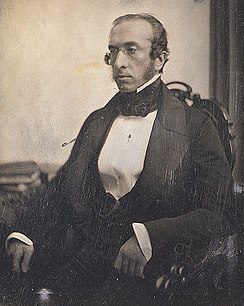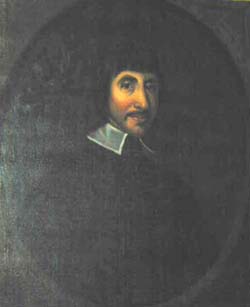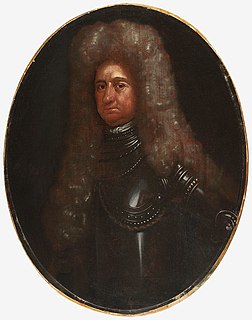See also
| This page lists people with the surname Winthrop. If an internal link intending to refer to a specific person led you to this page, you may wish to change that link by adding the person's given name(s) to the link. |
Winthrop is a surname.
Notable persons with that surname include:
| This page lists people with the surname Winthrop. If an internal link intending to refer to a specific person led you to this page, you may wish to change that link by adding the person's given name(s) to the link. |

John Winthrop was an English Puritan lawyer and one of the leading figures in founding the Massachusetts Bay Colony, the second major settlement in New England following Plymouth Colony. Winthrop led the first large wave of immigrants from England in 1630 and served as governor for 12 of the colony's first 20 years. His writings and vision of the colony as a Puritan "city upon a hill" dominated New England colonial development, influencing the governments and religions of neighboring colonies.

The Connecticut Colony or Colony of Connecticut, originally known as the Connecticut River Colony or simply the River Colony, was an English colony in New England which became the state of Connecticut. It was organized on March 3, 1636 as a settlement for a Puritan congregation, and the English permanently gained control of the region in 1637 after struggles with the Dutch. The colony was later the scene of a bloody war between the colonists and Pequot Indians known as the Pequot War. Connecticut Colony played a significant role in the establishment of self-government in the New World with its refusal to surrender local authority to the Dominion of New England, an event known as the Charter Oak incident which occurred at Jeremy Adams' inn and tavern.

The Winthrop Fleet was a group of 11 ships led by John Winthrop out of a total of 16 funded by the Massachusetts Bay Company which together carried between 700 and 1,000 Puritans plus livestock and provisions from England to New England over the summer of 1630, during the first period of the Great Migration.

Robert Charles Winthrop was an American lawyer and philanthropist and one time Speaker of the United States House of Representatives. He was a descendant of John Winthrop.

The Boston Brahmins or Boston elite are members of Boston's traditional old upper class. They are often associated with Harvard University, Anglicanism, the Somerset Club and traditional Anglo-American customs and clothing. Descendants of the earliest English colonists, such as those who came to America on the Mayflower in 1620 or on the Arbella in 1630, are often considered to be the most representative of the Boston Brahmins.
John Winthrop (1587/8–1649) was the founding governor of the Massachusetts Bay Colony.

Roger Ludlow (1590–1664) was an English lawyer, magistrate, military officer, and colonist. He was active in the founding of the Colony of Connecticut, and helped draft laws for it and the nearby Massachusetts Bay Colony. Under his and John Mason's direction, Boston's first fortification, later known as Castle William and then Fort Independence was built on Castle Island in Boston harbor. Frequently at odds with his peers, he eventually also founded Fairfield and Norwalk before leaving New England entirely.

John Winthrop the Younger was an early governor of the Connecticut Colony, and he played a large role in the merger of several separate settlements into the unified colony.

John Mason, was an early English settler, soldier, commander, and Deputy Governor of the Connecticut Colony. Mason was best known for leading the English settlers at an attack on the Pequot and the Mystic Fort, an event that ended up being known as the Mystic Massacre which effectively ended the hegemony of the Pequot tribe in southeast Connecticut.

The Saybrook Colony was an English colony established in late 1635 at the mouth of the Connecticut River in present-day Old Saybrook, Connecticut by John Winthrop, the Younger, son of John Winthrop, the Governor of the Massachusetts Bay Colony. Winthrop the Younger was designated Governor by the original settlers, including Colonel George Fenwick and Captain Lion Gardiner. They claimed possession of the land via a deed of conveyance from Robert Rich, 2nd Earl of Warwick. The colony was named in honor of Lords Saye and Brooke, prominent Parliamentarians and holders of the colony's land grants.

Arbella or Arabella was the flagship of the Winthrop Fleet on which Governor John Winthrop, other members of the Company, and Puritan emigrants transported themselves and the Charter of the Massachusetts Bay Company from England to Salem between April 8 and June 12, 1630, thereby giving legal birth to the Commonwealth of Massachusetts. John Winthrop is reputed to have given the famous "A Model of Christian Charity" sermon aboard the ship. Also on board was Anne Bradstreet, the first European female poet to be published from the New World, and her family.

Lion Gardiner (1599–1663) founded the first British settlement in New York on Long Island. His legacy includes Gardiners Island, which is held by his descendants.
Elizabeth Fones Winthrop Feake Hallett was an early settler in the Massachusetts Bay Colony. In 1640 Elizabeth, with her then-husband Robert Feake, were founders of Greenwich, Connecticut.

Fitz-John Winthrop, was the governor of the Colony of Connecticut from 1698 until his death on November 27, 1707.
Henry Winthrop (1608–1630) was the second son of John Winthrop, founder and Governor of the Massachusetts Bay Colony. In addition to his taking part in his father's Great Migration to America in 1630, Henry is part of American history for being the first husband of Elizabeth Fones, who would later be a founding settler of what is now Greenwich, Connecticut, but also be at the center of scandal in colonial America, as captured in the popular novel, The Winthrop Woman.
Waitstill Winthrop was a colonial magistrate, military officer, and politician of New England.
Grenville Lindall Winthrop (1864-1943) was an American lawyer and art collector from New York City. A direct descendant of John Winthrop, the first governor of the Massachusetts Bay Colony, he restored historic buildings in Lenox, Massachusetts and assembled a large art collection in his Upper East Side townhouse. He bequeathed his entire art collection to the Fogg Art Museum of his alma mater, Harvard University.
Frederic Bronson Winthrop was an American philanthropist and lawyer with Winthrop & Stimson who was prominent in New York society during the Gilded Age.

Thomas Buchanan Winthrop was an American philanthropist and lawyer who was prominent in New York society during the Gilded Age.